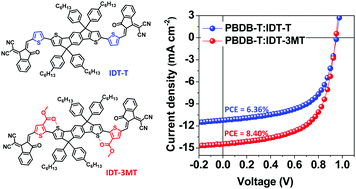Effect of a methyl thiophene-3-carboxylate bridge in an indacenodithiophene-based acceptor–donor–acceptor-type molecule on the performance of non-fullerene polymer solar cells†
Abstract
A new A-b-D-b-A-type n-type small molecule, IDT-3MT, was synthesized bearing a weak acceptor thiophene-3-carboxylate bridge (3MT = b) between indacenodithiophene as a donating core and 2-(3-oxo-2,3-dihydroinden-1-ylidene)-malononitrile as the accepting end groups. Compared to IDT-T bearing a neat thiophene bridge, IDT-3MT displayed a red-shifted absorption spectrum in the film state, which is a more effective complementary absorption behavior with PBDB-T as the donor material. The highest occupied molecular orbital and lowest unoccupied molecular orbital levels of IDT-3MT became correspondingly lower. Based on the results of grazing-incidence wide-angle X-ray scattering, the blend film of PBDB-T:IDT-3MT exhibited a more prominent face-on orientation and fine surface morphology compared with PBDB-T:IDT-T, which can facilitate charge transportation in the vertical direction. Among the two acceptors, the polymer solar cell based on a solvent additive-free as-cast PBDB-T:IDT-3MT blend film exhibited the highest power conversion efficiency of 8.40% with a high open-circuit voltage of 0.95 V and a short-circuit current density of 14.43 mA cm−2 due to the more prominent face-on orientation and favorable morphology of the blend film. According to the simple structural modification of the acceptor molecule, the ester group in the thiophene bridge played an important role toward achieving high-performance polymer solar cells.

- This article is part of the themed collection: Editor’s Choice: Organic Photovoltaics


 Please wait while we load your content...
Please wait while we load your content...